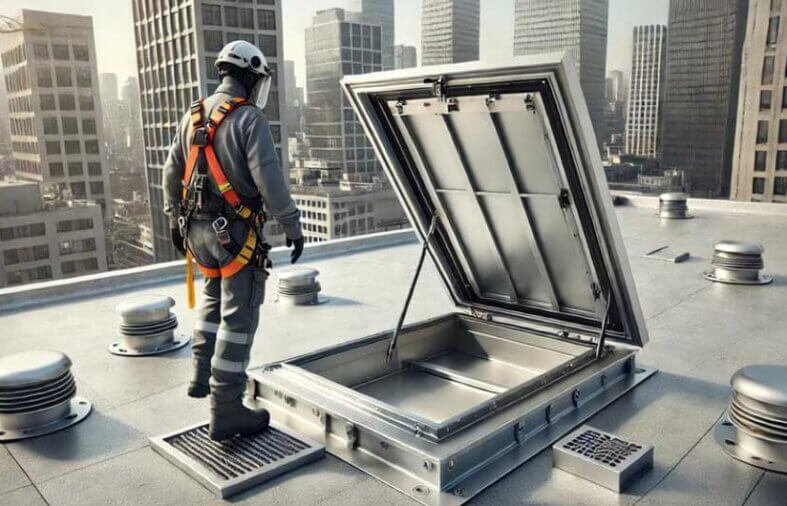Falls from roofs contribute to one-third of all fall-related accidents and can result in injuries or even fatalities. Data from the Centers for Disease Control and Prevention reports that falls kill approximately 300-400 construction workers each year.
Roof hatch doors offer a solution by ensuring secure and convenient rooftop entry. Keep reading to learn about their numerous advantages and why they are a great investment for residential, commercial, and industrial buildings.
Enhancing Building Access
Installing a roof hatch door improves building accessibility. It provides a convenient and safe entry point to the roof for various purposes. This hatch allows users to easily transport tools and materials to the roof, saving time and reducing physical strain.
Moreover, it enables safe access to inspect and service roof materials or rooftop equipment such as HVAC systems, solar panels, and satellite dishes. The direct and secure route it provides minimizes repair downtime and enables more frequent preventive maintenance. A roof hatch can also be a crucial access point for emergency responders.
Ensuring Safety and Security
With the alarming statistics related to roof falls, safety has become a critical concern in roof access. In emergencies, roof hatch doors transform into an important building feature. Should a fire or other unexpected crisis occur, these doors provide a secure and dependable route, enabling occupants to exit the building safely and quickly.
Moreover, roof hatch doors contribute to a property’s regulatory good standing. These doors meet Occupational Safety and Health Administration (OSHA) requirements, which mandate that buildings have adequate access for inspection and maintenance. Installing them can protect owners from potential penalties and fines.
Furthermore, roof hatch doors contribute to fall prevention. They often feature non-slip and textured surfaces to minimize the risk of slips and falls. They can also be integrated with guardrails and other safety measures to enhance protection. Investing in a roof hatch door creates a safer, more compliant environment for workers and building occupants.
Providing Weather Protection and Durability
Roofs are relentlessly exposed to harsh weather conditions such as rain, snow, wind, and extreme temperatures. These elements damage roofing materials, leading to leaks, structural issues, and increased maintenance costs.
A high-quality roof hatch door can withstand these challenges and provide long-lasting weather protection.
Roof hatch doors are typically constructed using durable materials such as aluminum, steel, or fiberglass, which are corrosion- and weathering-resistant. These doors also feature proper sealing and insulation to prevent moisture and air infiltration, safeguarding the roof and building interior. They protect a property from the elements and avoid costly repairs.
Contributing to Energy Efficiency and Environmental Protection
Green building practices are increasingly crucial in today’s environmentally conscious world. Modern roof hatch doors contribute to energy efficiency and environmental protection. Many models have features that improve ventilation and let in natural light, reducing the reliance on artificial lighting and cooling systems. This, in turn, lowers energy use and carbon footprint.
Well-designed roof hatches also minimize heat transfer through insulated panels, weatherstripping, and high-quality seals. These features can reduce the workload on the heating and cooling systems, lowering energy bills.
The strategic use of these doors supports green building initiatives and helps property owners and construction professionals achieve the Leadership in Energy and Environmental Design certification. They contribute to a building’s sustainability while providing energy savings and comfort.
Adapting to Various Building Types
Like other access doors and panels, roof hatch doors are incredibly versatile. They can adapt to fit different building types and purposes.
In residential properties, such as homes, condominiums, and apartments, roof hatch doors provide convenient access to the roof for maintenance, inspections, and even emergency escapes. They can also be used to access rooftop amenities like solar panels or gardens.
Commercial buildings also benefit significantly from roof hatch doors. They provide building managers and maintenance crews with efficient access to rooftop HVAC systems, communication equipment, and green spaces in office complexes. In retail spaces, they enable quick servicing of signage and lighting fixtures.
Meanwhile, industrial facilities have unique requirements for roof access. Roof hatch doors are ideal for accessing rooftop equipment, conducting inspections, and facilitating emergency evacuations. They can also be customized with features like heavy-duty hinges and reinforced frames to meet the specific needs of industrial environments.
Conclusion
Roof hatch doors offer crucial benefits, including enhanced safety, improved accessibility, weather protection, energy efficiency, and adaptability across various building types.
Investing in high-quality roof hatch doors is a smart decision, providing long-term value through increased safety, easier maintenance, and improved building performance. These versatile additions prove invaluable across residential, commercial, and industrial settings.








